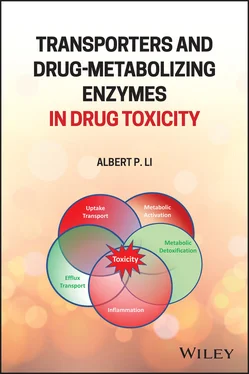1 ...7 8 9 11 12 13 ...28 Efficient export of bile salts and acids is essential, as their accumulation can be toxic for hepatocytes due to their detergent‐like effects. Drug interactions or genetic defects that impair hepatic transporters involved in bile salt or phospholipid secretion can result in intrahepatic cholestasis ( Table 2.1). For example, mutations in ABCB3 , which encodes the phospholipid transporter MDR3, can cause progressive familial intrahepatic cholestasis 3, a condition that usually presents as cholestasis in early childhood and may progress to end‐stage liver disease [31]. MDR3 is inhibited by azole antifungals, including ketoconazole, itraconazole, and posaconazole [33]. Loss‐of‐function mutations in ABCB11 , the gene encoding the BSEP, cause progressive familial intrahepatic cholestasis 2 [31] and drugs that inhibit the BSEP, such as bosentan, cyclosporin A, and troglitazone, can induce cholestatic DILI [34, 35].
Table 2.1 Genetic diseases related to hepatic transporters.
| Gene/protein |
Function |
Related disease |
Clinical phenotypes |
References |
| Basolateral influx transporters |
| SLCO1B1 organic‐anion transporting polypeptide 1B1 (OAT1B1) |
Sodium‐independent uptake of drugs and endogenous compounds, including bilirubin, bile acids, and statins |
Rotor syndrome, caused by deficiency in both OATP1B1 and OATP1B3 |
Conjugated hyperbilirubinemia, coproporphyrinuria |
[27] |
| SLCO1B3 Organic‐anion transporting polypeptide 1B3 (OATP1B3) |
| SLC10A1 sodium taurocholate co‐transporting polypeptide (NTCP) |
Sodium‐dependent bile acid uptake transporter. Also transports statins |
NTCP deficiency |
Extreme elevated levels of bile salts |
[30] |
| Canalicular efflux transporters |
| ATP8B1 ATPase phospholipid transporting 8B1 |
ATP‐dependent translocation of aminophospholipids into bile lumen |
Progressive familial intrahepatic cholestasis 1 |
Cholestasis in children |
[31] |
| ABCB4 multidrug resistance protein 3 (MDR3) |
ATP‐dependent translocation of phosphatidylcholine into bile lumen |
Progressive familial intrahepatic cholestasis 3 |
Cholestasis in children |
[31] |
| ABCB11 bile salt export pump (BSEP) |
ATP‐dependent bile acid transport into bile lumen |
Progressive familial intrahepatic cholestasis 2 |
Cholestasis in children |
[31] |
| ABCC2 MRP2: multidrug resistance associated protein 2 |
ATP‐dependent transport bilirubin and drug metabolites transport into bile lumen |
Dubin–Johnson syndrome |
Conjugated hyperbilirubinemia, jaundice |
[32] |
Increasing evidence has shown that in vitro inhibition of the BSEP is one of the essential mechanisms leading to DILI and is also a recognized risk factor for DILI [34, 36]. However, it has been suggested that BSEP inhibition alone might not be a good predictor of DILI risk [37] as drugs inhibiting the BSEP often inhibit other transporters as well, and it may be the cumulative effect that causes toxic bile acid accumulation [38]. In support of this theory, hepatoxicity induced by isoniazid and rifampicin may be due to the inhibition of both NTCP and BSEP [39]. Additionally, the discontinued HER2 tyrosine kinase inhibitor CP‐724,714 inhibits efflux transporters BSEP and MDR1, which contributes to the toxic accumulation of drug and bile acids [40].
2.5 Genetic Variants and Their Impact for Pharmacokinetic Behavior and Safety
Genetic variation can result in decreased, unchanged, or increased enzymatic function [41, 42], and therefore could significantly impact drug safety by altering pharmacokinetic characteristics in certain individuals [43]. Based on decades of pharmacogenetic research, the association between genetic variation and drug metabolism has been established for many drugs [44]. The FDA has published a list of pharmacogenetic associations with sufficient scientific evidence [45]. However, often contradictory evidence for a given drug is reported, usually due to the limited statistical power in many studies. This is of particular importance in establishing associations between genotypes and DILI, as DILI has a very low incidence (~20 per 100 000 inhabitants annually) and clinical diagnosis is challenging [46]. The association between genotype and hepatotoxicity has been suggested for CYP2C9‐Bosentan, NAT2‐isoniazid and others ( Table 2.2).
Table 2.2 Selected reports for the association between gene variations and drug‐induced liver injury.
| Gene |
Variant |
Function |
Affected subgroups |
Drug |
DILI risk association |
References |
| CYP2B6 |
*1H and *1J (‐2320T>C) |
Increased expression |
Ultrarapid metabolizers |
Ticlopidine |
Increased risk |
[47] |
| CYP2B6 |
*6 |
Decreased function |
Poor metabolizers |
Efavirenz |
Increased risk |
[48] |
| CYP2C9 |
*2 |
Decreased function |
Poor metabolizers |
Bosentan |
Increased risk |
[49, 50] |
| CYP2E1 |
c1/c1 |
Increased expression |
Ultrarapid metabolizers |
Isoniazid |
Increased risk |
[51] |
| NAT2 |
*4 |
Without active alleles |
Slow acetylators |
Isoniazid |
Increased risk |
[51–53] |
| UGT1A6 |
A528G |
Silent mutation |
|
Tolcapone |
Increased risk |
[54] |
| UGT2B7 |
*2 |
Decreased function |
Poor metabolizers |
Diclofenac |
Increased risk |
[55, 56] |
| GSTM1 and GSTT1 |
Double null genotype |
Decreased function |
Poor metabolizers |
Troglitazone |
Increased risk |
[57] |
| ABCB1 |
3435C>T |
Decreased expression |
|
Nevirapine |
Decreased risk |
[58, 59] |
| ABCB11 |
D676Y, G885R and V444A |
Decreased function |
|
Ethinylestradiol/gestodene |
Increased risk |
[60] |
| ABCC2 |
C‐24T |
Decreased expression |
|
Diclofenac |
Increased risk |
[55] |
| ABCC2 |
C‐24T |
Decreased expression |
|
Deferasirox |
Increased risk |
[61] |
For the major CYPs the single nucleotide polymorphism (SNP) has been estimated to be 14–127 per kilobase pair [62]. Of these SNPs, 9–41% are nonsynonymous variants. Only a limited number of SNPs (6–30%) have been cataloged or functionally annotated by the Pharmacogene Variation (PharmVar) Consortium, a public central repository for pharmacogene (PGx) variation ( www.pharmvar.org). In addition to SNPs, variations such as insertions and deletions are present. The polymorphism phenotype can be categorized into four types; i.e. poor metabolizer, intermediate metabolizer, extensive metabolizer, and ultra rapid metabolizer. Poor metabolizer usually refers to individuals carrying homozygous or compound heterozygous null alleles (no function). In intermediate metabolizers one allele is partially defective while the other either is partially defective or null. For extensive metabolizers at least one allele is fully functional. Individuals with gain‐of‐function polymorphisms, e.g. carrying extra gene copies and mutations that enhance enzyme activity, belong to the ultra rapid metabolizer category.
Читать дальше












